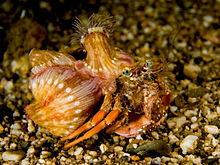- Dardanus pedunculatus
-
Dardanus pedunculatus 
Scientific classification Kingdom: Animalia Phylum: Arthropoda Subphylum: Crustacea Class: Malacostraca Order: Decapoda Superfamily: Paguroidea Family: Diogenidae Genus: Dardanus Species: D. pedunculatus Binomial name Dardanus pedunculatus
(J. F. W. Herbst, 1804)Synonyms [1] - Cancer pedunculatus Herbst, 1804
- Pagurus asper De Haan, 1849
- Pagurus sigmoidalis Zehntner, 1894
- Dardanus haani Rathbun, 1902
- Neopagurus horai Kaamalaveni, 1950
Dardanus pedunculatus, the anemone hermit crab, is a species of hermit crab from the Indo-Pacific region. It lives at depths of up to 27 m and collects sea anemones to place on its shell for defence.
Contents
Distribution
Dardanus pedunculatus has a broad distribution in the Indo-Pacific region, from the Seychelles in the west to Japan and Hawaii in the east. In Australia, it is found from New South Wales (as far south at Port Jackson[2]) to Queensland.[1]
Ecology
D. pedunculatus usually lives on coral reefs and in the intertidal zone, at depths of 1–27 metres (3–89 ft).[1] It usually carries sea anemones on its shell, which it uses to protect itself from its main predator, cephalopods of the genus Octopus.[3] The anemones are collected at night,[3] and comprises the crab stroking and tapping the anemone until it loosens its grip on the substrate, at which point it is moved onto the gastropod shell that the hermit crab inhabits.[4]
Description
Dardanus pedunculatus usually attain a maximum size of 10 centimetres (4 in).[4] The carapace is mottled in tan and cream, while the eyestalks are white with red bands.[2] The sexes are similar.[3] The left claw is much larger than the right claw.[2]
Pets
Hermit crabs are popular pets in marine aquaria, and Dardanus pedunculatus is occasionally kept, although the species has not been successfully reared in captivity.[3]
Taxonomic history
Dardanus pedunculatus was first described by Johann Friedrich Wilhelm Herbst as Cancer pedunculatus, in his 1804 work Versuch einer Naturgeschichte der Krabben und Krebse nebst einer Systematischen Beschreibung ihrer verschiedenen Arten;[1] the type locality is not known.[5] It has since been placed in a number of different genera, including Pagurus and Neopagurus, and a number of taxonomic synonyms have been created.[1]
References
- ^ a b c d e P. J. F. Davie (2002). "Dardanus pedunculatus". Zoological catalogue of Australia: Crustacea: Malocostraca: Eucarida (Part 2), Decapoda: Anomura, Brachyura. Volume 19 of Zoological catalogue of Australia, Australia. Bureau of Flora and Fauna. CSIRO Publishing. p. 50. ISBN 9780643056770. http://books.google.co.uk/books?id=jr9SR1Cr5BAC.
- ^ a b c Gary C. B. Poore & Shane T. Ahyong (2004). "Dardanus pedunculatus". Marine decapod Crustacea of southern Australia: a guide to identification. CSIRO Publishing. p. 257. ISBN 9780643069060. http://books.google.co.uk/books?id=ZZWnuGc0xlMC.
- ^ a b c d Helmut Debelius (1994). "Dardanus pedunculatus". Marine atlas: The joint aquarium care of invertebrates and tropical marine fishes, Volume 1. Steven Simpson Books. p. 606. ISBN 9783882440515. http://books.google.co.uk/books?id=EOY28s5U9ukC.
- ^ a b Gerald Allen (2000). "Anemone Hermit Crab (10 cm)". Marine Life of the Pacific and Indian Oceans. Periplus nature guides. Tuttle Publishing. p. 35. ISBN 9789625939483.
- ^ Dwi Listyo Rahayu (2000). "Hermit crabs from the South China Sea (Crustacea: Decapoda: Anomura: Diogenidae, Paguridae, Parapaguridae)" (PDF). Raffles Bulletin of Zoology Suppl. 8: 377–404. http://rmbr.nus.edu.sg/rbz/biblio/s8/s08rbz377-404.pdf.
Categories:- Hermit crabs
- Symbiosis
- Indo-Pacific crustaceans
- Animals described in 1804
Wikimedia Foundation. 2010.
